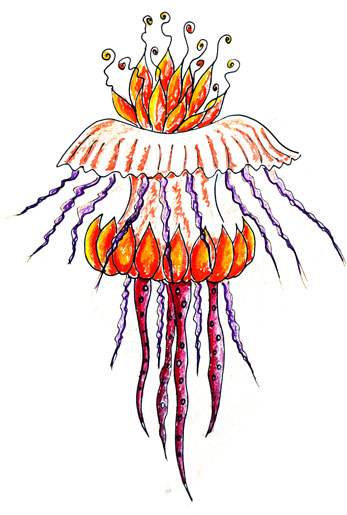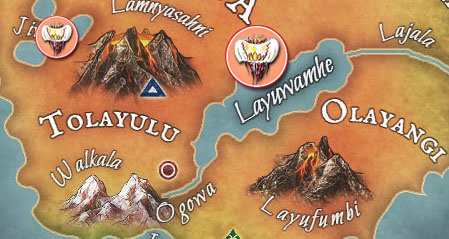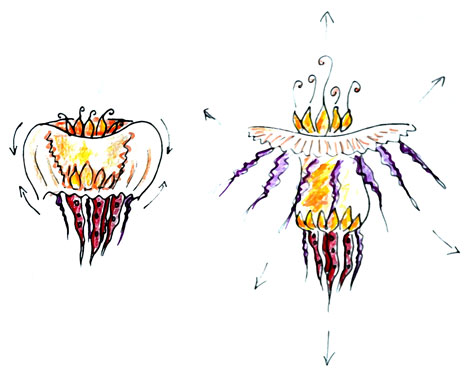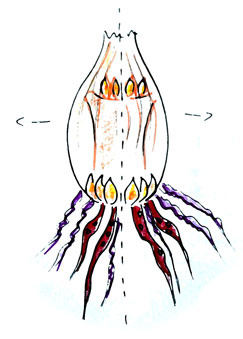Jinitamba - Spark animal (ʒi.ni.'ta:.m.ba)
Jinitamba, or the spark animal, is an aquatic creature found in the warm Layid inland waters. It reaches an average size of around 12.5 centimeters and usually has striking colors such as yellow, orange and red. Different shades of color are possible, which depends, among other things, on the water temperature and the composition of the food.
Since the discovery of Spark symbiosis symbiosis, they have been bred in addition to the naturally occurring spark animals in the inland seas, especially in fire magic sites. Despite their use, they are not protected because the molluscs divide regularly under optimal conditions.
Physiology & lifestyle
The body consists of the slightly transparent umbrella and belly. Above the umbrella, sparking tentacles push out of the umbrella opening like a kind of head. There are small luminous bodies at the ends of the tentacles, which primarily attract plankton or small fish as food. Below the umbrella and belly there are purple tentacles that are used for movement in the water. In addition, there are dark red tentacles below the abdomen that capture the attracted food and lead it to the "mouth" under the abdomen for digestion.
At a Glance
Scientific name:Hyra JINITAMBI ernola
Common name: Spark animal
Line: fire jellyfish
Lineage: tentacle-bearing
Habitat: Inland waters on Layida
Life expectancy: approx. 20 years depending on water temperature
Size: 12,5 cm
Weight: 4 g
Speed: approx. 5 km/h
Appearance: transparent belly and umbrella, tentacles with luminous bodies on the head, tentacles, color shades in orange, red, purple
Food: plankton, small fish
Reproduction: Division about 5 per year
Movement
The spark animal moves by, in the first step, pulling its stomach and the sparking tentacles back into the umbrella and in the second step, both are pressed out of the umbrella again. This means that movements in all directions are actually possible.
Reproduction & Life Expectancy
The Jinitamba reproduces by division. It puts the umbrella over the sparking tentacles and folds itself in half. After division, the remaining umbrella grows back together and the missing tentacles and tentacles grow back. This process takes about three to four hours. The optimal water temperature for division is between 25°C and 40°C. The warmer the temperatures, the more frequently the fungi divide, resulting in a shorter life expectancy. The Jinitamba divides approximately five times per year. With an increase in water temperature by 5°C, the division rate increases to seven times per year, etc.
Jinitamba have a life expectancy of around 20 years in the wild and at a breeding temperature of 25°C. Since the sparkling animals reproduce by division, this means that after this time there will no longer be any cells from the “primordial animal”. If they are used as a symbiont in spark symbiosis, they live for around 50 years. Then no division takes place because the renewal of the cells takes place via the symbiont.











Excellent article with great artwork!
Thank you ;).